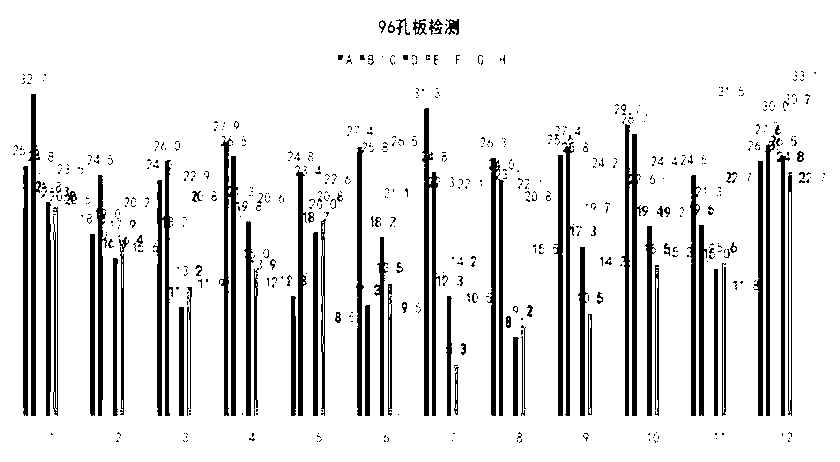Method for fast and efficient screening of high-yield 5-aminolevulinic acid mutant strain
A technology of aminolevulinic acid and mutant strains, which is applied in the field of bioengineering, can solve the problems such as difficulty in maintaining the blindness and excellent production traits of mutation breeding, increasing the difficulty of mutation breeding screening, and large screening workload, etc. The effect of screening workload, shortening screening cycle, and high screening accuracy
- Summary
- Abstract
- Description
- Claims
- Application Information
AI Technical Summary
Problems solved by technology
Method used
Image
Examples
Embodiment 1
[0011] a. The Rhodobacter sphaeroides that has undergone physical or (and) chemical mutagenesis treatment (the treatment method is the same as the prior art) to produce 5-aminolevulinic acid ( Rhodobacter sphaeroides ) (CICC No: 10278) Wash with physiological saline, resuspend in liquid medium, incubate at 32°C and dilute to make 10 4 A / ml bacterial suspension, apply the plate to a static culture, cultivate in the dark at 31°C for 4 days, and then form colonies on the plate;
[0012] b. Pick a single colony with a large and bright colony and inoculate it in a liquid medium in 96 wells of a 96 deep-well plate for 40 hours, and then add glycine, succinic acid and levulinic acid to the liquid medium, per liter Add 30mmol of glycine, 30mmol of succinic acid, and 45mmol of levulinic acid to the medium, and continue culturing for 24h; the liquid medium contains 9.0g glucose, 3.8g sodium glutamate, and 0.5 potassium hydrogen phosphate per liter of water. g, 0.5g potassium dihydrogen pho...
Embodiment 2
[0015] a. will undergo physical or (and) chemical mutagenesis (existing technology) to produce 5-aminolevulinic acid Rhodobacter sphaeroides ( Rhodobacter sphaeroides ) (CICC No: 10278) Wash with physiological saline, resuspend in liquid medium, incubate at 32°C and dilute to make 10 3 A / ml bacterial suspension, apply the plate to static culture, cultivate in the dark at 32°C for 4 days, colonies will be formed on the plate;
[0016] b. Pick a single colony with a large and bright colony and inoculate it in a 96-well liquid medium in a 96-deep-well plate for 48 hours, and then add glycine, succinic acid and levulinic acid to the liquid medium in an amount of Glycine 15mmol / L, succinic acid 20mmol / L, levulinic acid 30mmol / L, continue to cultivate for 24h; the liquid medium contains: glucose 9.0g, sodium glutamate 3.8g, and dipotassium hydrogen phosphate 0.5 per liter of water g, 0.5g potassium dihydrogen phosphate, 0.8g ammonium sulfate, 0.2g magnesium sulfate, 0.053g calcium chlo...
Embodiment 3
[0019] a. will undergo physical or (and) chemical mutagenesis (existing technology) to produce 5-aminolevulinic acid Rhodobacter sphaeroides ( Rhodobacter sphaeroides ) (CICC No: 10278) Wash with physiological saline, resuspend in liquid medium, culture at 31°C and dilute to make 10 4 A / ml bacterial suspension, apply the plate to static culture, cultivate in the dark at 32°C for 4 days, colonies will be formed on the plate;
[0020] b. Pick a single colony with a large and bright colony and inoculate it in a 96-well liquid medium in a 96-deep-well plate for 36 hours, and then add glycine, succinic acid and levulinic acid to the liquid medium in the amount of glycine 45mmol / L, succinic acid 40mmol / L, levulinic acid 60mmol / L, continue to cultivate for 24h; the liquid medium contains: glucose 9.0g, sodium glutamate 3.8g, and dipotassium hydrogen phosphate 0.5g per liter of water , Potassium dihydrogen phosphate 0.5g, ammonium sulfate 0.8g, magnesium sulfate 0.2g, calcium chloride 0....
PUM
 Login to View More
Login to View More Abstract
Description
Claims
Application Information
 Login to View More
Login to View More - R&D
- Intellectual Property
- Life Sciences
- Materials
- Tech Scout
- Unparalleled Data Quality
- Higher Quality Content
- 60% Fewer Hallucinations
Browse by: Latest US Patents, China's latest patents, Technical Efficacy Thesaurus, Application Domain, Technology Topic, Popular Technical Reports.
© 2025 PatSnap. All rights reserved.Legal|Privacy policy|Modern Slavery Act Transparency Statement|Sitemap|About US| Contact US: help@patsnap.com

